Students Submitting Online Assignments: Part 2
Published June 11th, 2018 by Emily
Since I last posted on this topic I have taken another online class with discussion boards. In this class, the professor decided to implement a new rule, hoping to facilitate more discussion between students, by requiring our first post to be made halfway through the week and then follow-up comments on other student's posts due by the end of the week.
I thought it would be interesting to look at how students fared with this new structure compared with the old structure, which only required one post at the end of the week.
The data
I looked at when all the assignments were submitted throughout the week and plotted that information.
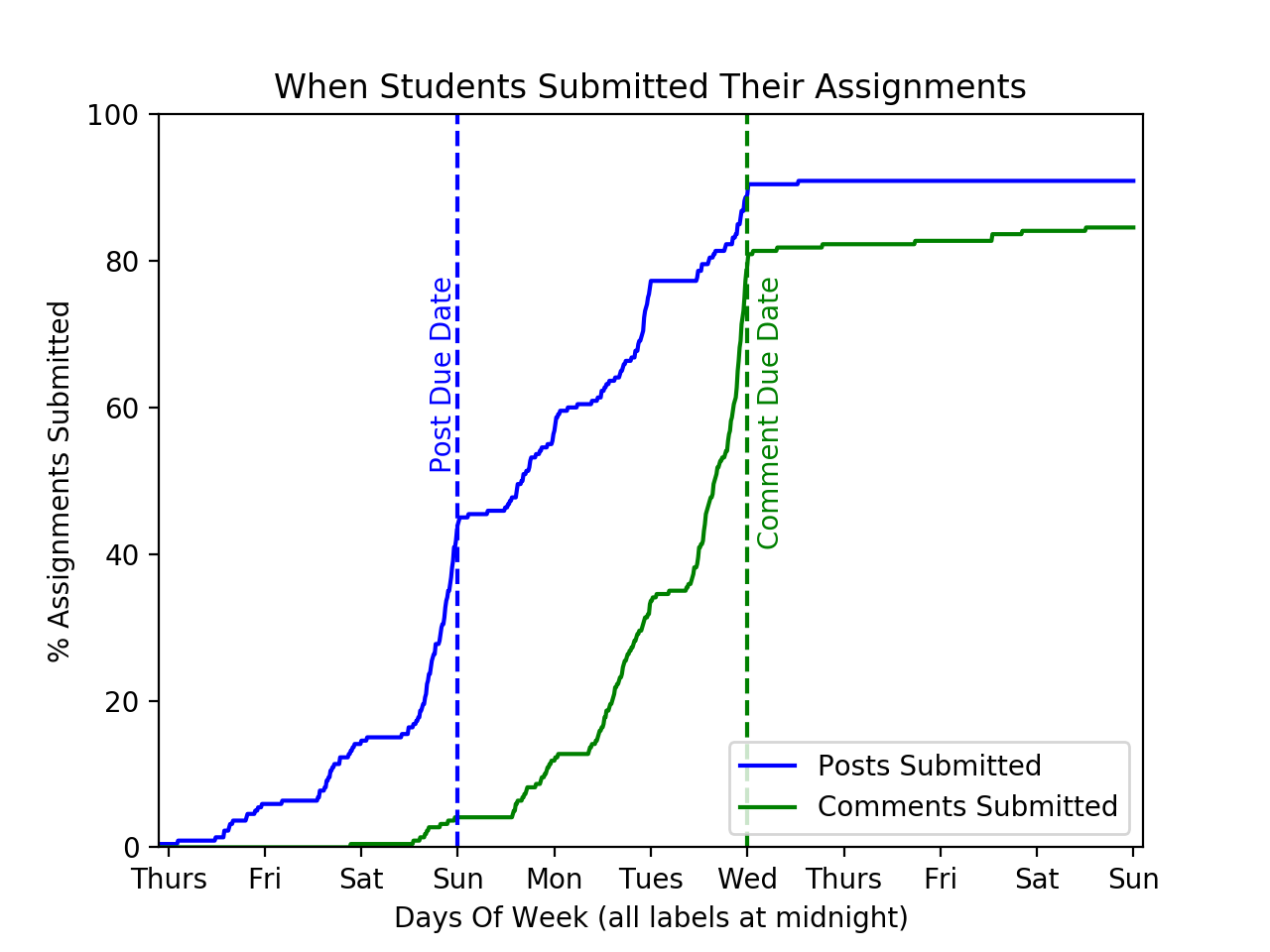
As expected, there is a large jump in posts submitted on Saturday night right before the due date at midnight on Sunday. However, posts continue to be submitted after the due date, and by the time the comments are due, 89% of the posts have been submitted. Only 2% of the posts are submitted after the week is entirely over, leaving about 10% unsubmitted.
The number of students who submitted their first post before the due date decreased from 70% to 45%

In my previous class 70% of the posts were made on-time (Note 2). The drop to a 45% on-time submission seemed dramatic, so I investigated several potential causes. The posts in this class were worth half as much when compared to the old class, so students may have decided turning in assignments on-time wasn't worth as much to them. However, I think the biggest cause for late assignments was that the due date for the first post was a Saturday night.
Is it possible the Saturday night deadline was responsible for the boom in late posts?

The pattern of when late assignments were submitted suggests that students have a hard time remembering to submit assignments on the weekend. There does not seem to be a spike in late assignments being submitted the day after the due date (as I saw in the previous class) or the day before the second due date (as you may expect from the new format). Instead there is a spike on Monday, presumably as students sit down in classes and look at the week's homework and realize they missed an assignment on Saturday night.
Almost every post had a comment
Almost 95% of posts received at least one comment. Of the ten posts that received no comments, nine of them were submitted less than twelve hours before the comments were due and one was submitted after the comments were due.
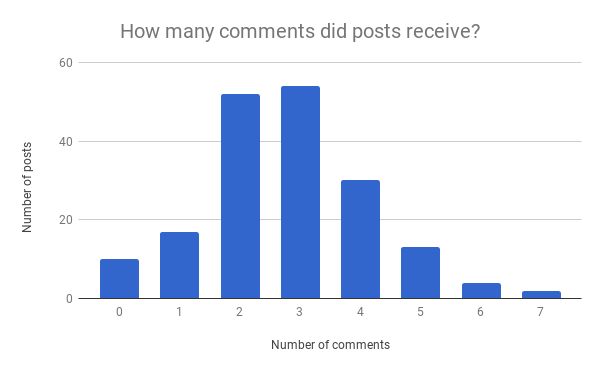
The discussion created by the comment rule creates far more discussion than I have experienced in any of my previous online classes. The next step to further the discussion would be to require students to respond to those that commented on their post. I was not able to use the data that I exported from Blackboard to find out if the rate of a conversation such as this was high, however in my experience from viewing the posts it seems that students that responded to comments on their own posts were in the minority.
Students' word count in posts dropped by a third over the course of the term
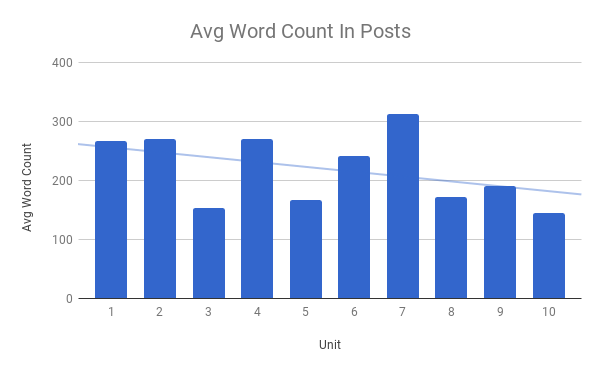
Over the course of the unit, students started to write less in their initial posts. From the beginning of the term to the end the word count decreased by 28%. However, there is enough variation in the data that I think it's possible that students had less things to say about the prompts at the end of the term.
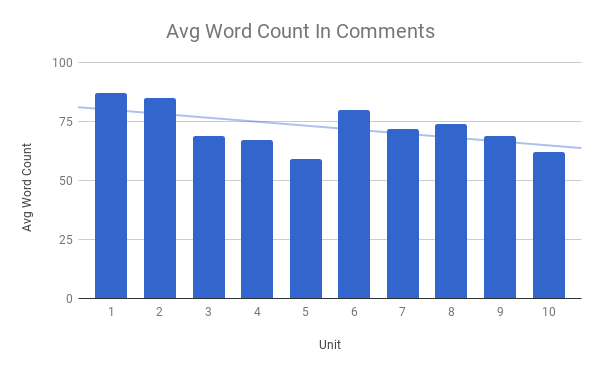
Although the word count only decreased by 19% in the comments, there is less variation in the amount students write.
How did the word count vary student-to-student?
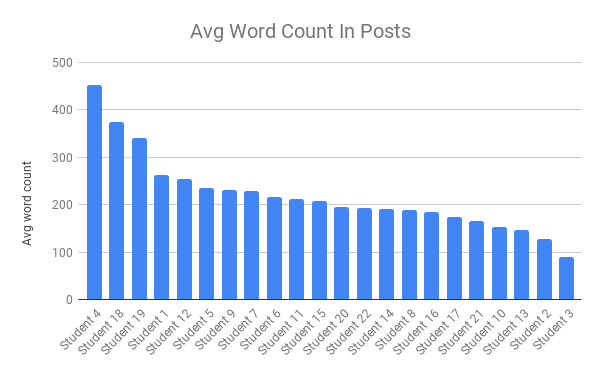
I showed this chart just because I really like the way the curve looked. There are clearly some high achievers, but don't be fooled purely by the word count: Student 19 wrote the third most words but only submitted three posts and no comments! Because students were able to read other students posts before composing their own, they likely tailored their post length to match that of their peers.
In summary...
-
This new format proved to promote discussion between the students, however requiring students to respond to the comments others made on their post may ensure a conversation takes place.
-
The schedule of having the initial post due on a Saturday night may have caused the unusually low rate of on-time submissions.
-
Students are less motivated to participate as time goes on, but not by an amount that the casual reader would notice.
-
Students generally write the same amount as their peers
Notes:
-
In original data set, it appears that one student dropped the class (posted in the first discussion board and never again) and one student was the professor who only posted once. These two individuals were removed from the data.
-
In the previous data set I had no way to keep track of assignments that were never turned in. I originally found that 77% of students turned their assignments in on-time, but I tried to factor in a number of assignments that were never turned in that was proportional to the number I had found in the new class. This brought the on-time submission rate in the previous class down to an estimated 70%, still much higher than the 45% on-time submission rate of the new class.